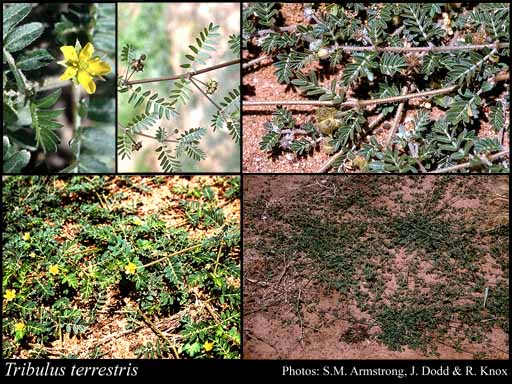- Reference
- Sp.Pl. [Linnaeus] 1:387 (1753)
- Conservation Code
- Not threatened
- Naturalised Status
- Alien to Western Australia
- Name Status
- Current
Prostrate annual, herb, plants villous; leaflet pairs 4-7; cocci with distinct divergent, median spines 3-8 mm long. Fl. yellow, Jan to Dec. Often on sandy soils. Waste places.

Distribution
- IBRA Regions
- Avon Wheatbelt, Carnarvon, Central Kimberley, Central Ranges, Coolgardie, Dampierland, Esperance Plains, Gascoyne, Gibson Desert, Great Sandy Desert, Great Victoria Desert, Jarrah Forest, Little Sandy Desert, Mallee, Murchison, Northern Kimberley, Nullarbor, Ord Victoria Plain, Pilbara, Swan Coastal Plain, Tanami, Victoria Bonaparte, Yalgoo.
- IBRA Subregions
- Ashburton, Augustus, Cape Range, Carnegie, Central, Chichester, Eastern Goldfield, Eastern Murchison, Edel, Fitzgerald, Fitzroy Trough, Fortescue, Hamersley, Hart, Katanning, Keep, Lateritic Plain, Mackay, Mann-Musgrave Block, Mardabilla, Merredin, Mitchell, Mount Eliza, Northern Jarrah Forest, Nullarbor Plain, Pentecost, Perth, Pindanland, Purnululu, Roebourne, Rudall, Shield, Southern Cross, Southern Jarrah Forest, South Kimberley Interzone, Tallering, Tanami Desert, Trainor, Western Mallee, Western Murchison, Wooramel.
- IMCRA Regions
- Canning, Kimberley, Leeuwin-Naturaliste.
- Local Government Areas (LGAs)
- Ashburton, Bridgetown-Greenbushes, Broome, Busselton, Carnarvon, Cockburn, Cue, Cunderdin, Derby-West Kimberley, Dundas, East Pilbara, Esperance, Exmouth, Goomalling, Gosnells, Halls Creek, Kalgoorlie-Boulder, Karratha, Kellerberrin, Kulin, Lake Grace, Laverton, Leonora, Melville, Merredin, Mingenew, Moora, Mount Magnet, Mukinbudin, Murchison, Narembeen, Nedlands, Ngaanyatjarraku, Northampton, Perenjori, Perth, Port Hedland, Ravensthorpe, Rockingham, Sandstone, Serpentine-Jarrahdale, South Perth, Swan, Toodyay, Trayning, Upper Gascoyne, Wanneroo, Waroona, Wickepin, Wiluna, Wongan-Ballidu, Wyndham-East Kimberley, Yilgarn.
Management Notes (for the Swan NRM Region)
General Biology. Growth form. Herb. Life form. Annual. Reproduction. Seed 'nutlets'. Dispersal. Dispersal of the burrs via tyres, water, machinery, soil movement and adhesion to animals, clothing, footwear.. Time of first flowering. Within three weeks of germination. Time of first fruiting. Within five to six weeks. Seedbank persistence. Can remain domant up to 5 years..
Notes. Caltrop produces sharp, spiny burrs throughout summer and autumn. Up to 1000 fruits can be produced on each plant, with a total of up to 20,000 seeds. Plants grow rapidly, flowering and forming new burrs within three to five weeks..
Additional information. Origin. Native to the Mediterranean, Africa, Asia and subtropical parts of Australia.. History of use/introduction. Thought to have been introduced to Southern Australia through contaminated seeds from Europe.. Similar exotic species. Tribulus cistoides. Similar native species. Tribulus occidentalis.
Suggested method of management and control. Preventing the spread of Caltrop is the best control measure. Prevent spread through cleaning of equipment, clothing, vehicles that have been used in infested areas. Hand removal can be effective for small infestations, care must be given to removing the deep tap root and the seeds should be burnt. Herbicide use can also be effective, spraying needs to be done before seeds set and repeated for each germination of seedlings. Pasture management or renovation to provide competition is often the key to caltrop control in pasture. Read the manufacturers' labels and material safety data sheets before using herbicides. For further information consult the Australian Pesticides and Veterinary Medicines Authority to determine the status of permits for your situation or state.
Management Calendar
| Calendar Type | Jan | Feb | Mar | Apr | May | Jun | Jul | Aug | Sep | Oct | Nov | Dec | Comments |
|---|---|---|---|---|---|---|---|---|---|---|---|---|---|
| Germination | Y | Y | Y | Y | Y | Y | Y | Y | Y | Y | Y | Y | |
| Active Growth | Y | Y | Y | Y | Y | Y | Y | Y | Y | Y | Y | Y |
Legend: Y = Yes, regularly, O = Occasionally, U = Uncertain, referred by others but not confirmed.
References
- Boydston, R.A. (1990) Time of emergence and seed production of long spine sandburr (Cenchrus longispinus) and puncturevine (Tribulus terrestris). Weed Science, 38: 16-21.
- Brown, K. & Brooks, K. (2002) Bushland Weeds: A Practical Guide to their Management. Environmental Weeds Action Network, Greenwood.
- Department for Environment and Water 2013 (2018) Pest Plants. URL: https://www.naturalresources.sa.gov.au/kangarooisland/plants-and-animals/pest-plants - Accessed June 2019.
- Department of Primary Industries, Victoria (2009) Impact Assessment - Caltrop (Tribulus terrestris) in Victoria. The State of Victoria URL: http://www.dpi.vic.gov.au/dpi/vro/vrosite.nsf/pages/impact_caltrop - Accessed July 2010.
- El-Ghareeb, R.M. (1991) Suppression of annuals by Tribulus terrestris in an abandoned field in the sandy desert of Kuwait. Journal of Vegetation Science, 2: 147-154.
- Hon lan Hunter MP (2014) Declared Plant Policy under the Natural Resources Management Act 2004. URL: https://www.pir.sa.gov.au/biosecurity/weeds_and_pest_animals/weeds_in_sa/plant_policies/pest_weed_policies/declared_plants_2/caltrop_policy.pdf - Accessed June 2019.
- Hussey, B.M.J., Keighery, G.J., Dodd, J., Lloyd, S.G. & Cousens, R.D. (2007) Western Weeds. A guide to the weeds of Western Australia. 2nd Edition. The Plant Protection Society of Western Australia, Victoria Park.
- Northern and Yorke NRM Board (2009) Caltrop (Tribulus terrestris), NRM Plan Factsheet No.1.016. Government of SA, Crystal Brook, South Australia.
- Parsons, W.T. & Cuthbertson, E.G. (2001) Noxious weeds of Australia. 2nd Edition. CSIRO Publishing, Collingwood.